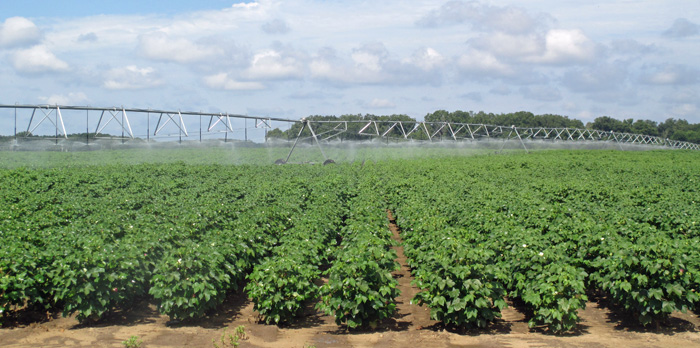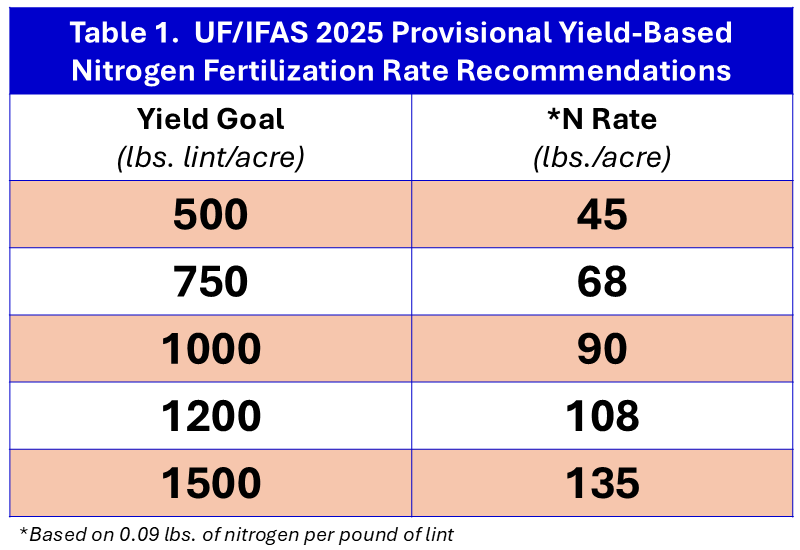Ethan Carter, Regional Crop IPM Extension Agent; Hardeep Singh, Cropping Systems Specialist; Michael Dukes, Director of UF/IFAS Center for Land Use Efficiency; and Lakesh Sharma, State Ag BMP Coordinator

Combined analysis from research trials across five states in 2002 and 2023 found that 0.09 lb. of nitrogen is required to produce one pound of lint. Photo credit: Doug Mayo, UF/IFAS
In recent years, the University of Florida has worked diligently to implement required research trials necessary to update its antiquated cotton nitrogen fertilization recommendation of 60 units/acre. Research performed both on-farm and at research and education centers in 2022 and 2023 has resulted in the implementation of a provisional yield goal-based approach to cotton nitrogen management for the 2025 growing season.
Combined analysis of research trials conducted across five sites from 2022-23 found that 0.09 lbs. of nitrogen (N) is required to produce one lb. of cotton lint. Therefore, a yield-based nitrogen recommendation can be calculated by multiplying the expected lint yield goal by 0.09 (example: 800 lb./acre goal * 0.09 = 72 lbs. N/acre rate). Below, Table 1. provides additional examples for yield goals and associated recommended N fertilization rates per acre. Following the yield goal-based method, producers have the ability to adjust nitrogen rates by field according to realistic yield expectations.
In accordance with the FDACS BMP Manual for Vegetable and Agronomic Crops, producers may also apply a single supplemental nitrogen (N) application following leaching rainfall events. A leaching event is defined as 3 inches of rain in 3 days, or 4 inches in 7 days, and the supplemental application can be up to 30 lbs. N/acre. An excerpt from page 27 – 1.1.3 of the manual is provided below:
“Match plant growth stage N and P requirements and minimize N and P loss through leaching or runoff by using seasonal applications, split applications, or controlled release/enhanced efficiency fertilizer. If rainfall exceeds 3 inches in 3 days or 4 inches in 7 days, Producers may apply a single supplemental application of N (up to 30 pounds per acre). This supplemental application must occur as soon as practicable following the event but cannot occur within 10 days of the next regularly scheduled application of N. Producers must keep copies of all application records as well as rainfall data and any other records used to justify the supplemental N application.” Florida Vegetable and Agronomic Crop (VAC) Operations BMP Manual 2024 Edition
–
UF/IFAS cotton recommendations pertaining to other nutrients remain unchanged and producers should follow UF/IFAS Standardized Fertilization Recommendations for Agronomic Crops, note that footnotes 107 and 124 still apply.
- Apply all of the P2O5 and 30% of the K2O and N in a pre-plant or at-planting application. Apply the remaining 70% of the K2O and N in one sidedressing.
_ - UF/IFAS fertilization and liming recommendations are advisory in nature and emphasize efficient fertilizer use and environmentally sound nutrient management without losses of yield or crop quality. It is generally assumed the nutrients will be supplied from purchased, commercial fertilizer and the expected crop yields and quality will be typical of economically viable production. Growers should consider IFAS recommendations in the context of their entire management strategy, such as return on investment in fertilizer and the benefits of applying manure or biosolids (sewage sludge) to their land.
–
Resources and Additional Information:
UF/IFAS Nutrient Management Recommendation Series: Cotton
Cotton Nitrogen Fertilization Rate Study 2023 Mid-Season Update
May Update on the Cotton Nitrogen Rate Research Project
- 2025 Peanut Field Day Recap & Speaker Handouts - August 29, 2025
- Peanut Foliar Diseases Exploding Across Florida - August 22, 2025
- Provisional Nitrogen Fertilization Recommendation for Florida Cotton for the 2025 Season - June 20, 2025

